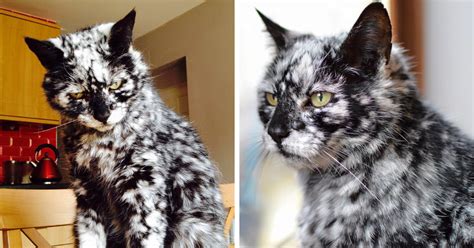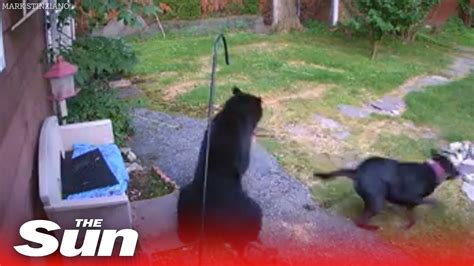
A black cat named Ellie is captivating hearts online with her unique, star-like appearance caused by vitiligo, a skin condition resulting in loss of pigmentation. Her transformation has turned her sleek, black coat into a dazzling display resembling a miniature galaxy, earning her the affectionate nickname “Stardust Kitty.”
Ellie, originally entirely black, began developing white spots around her eyes and ears in 2018, a change her owner, Brandi Thomas, initially found concerning. “At first, I was worried,” Thomas admitted. However, after a veterinary examination, Ellie was diagnosed with vitiligo, a condition that affects melanin production, the pigment responsible for skin and hair color. While it’s primarily known to affect humans, vitiligo can also occur in animals, including cats.
Over the past six years, Ellie’s transformation has been gradual but remarkable. The white patches have spread across her body, creating a striking contrast against her remaining black fur. The resulting pattern resembles a starry night sky, with each white spot appearing like a distant star. This ethereal look has garnered Ellie a significant following on social media, where Thomas regularly shares updates on her feline companion’s ever-evolving appearance.
“She’s just the sweetest cat,” Thomas said, emphasizing that vitiligo doesn’t affect Ellie’s health or temperament. “She loves to cuddle and play, just like any other cat.” Ellie’s story has not only raised awareness about vitiligo in animals but also highlighted the beauty of embracing individuality and celebrating differences. Her unique appearance serves as a reminder that what makes us different is often what makes us special.
The internet has embraced Ellie’s cosmic makeover. Her photos and videos have been shared widely, with many expressing their admiration for her unique beauty. Some have even commented on the symbolic nature of her transformation, seeing it as a representation of resilience and embracing change.
Vitiligo in animals, like in humans, is an autoimmune condition. It occurs when the immune system mistakenly attacks melanocytes, the cells responsible for producing melanin. This destruction of melanocytes leads to depigmentation, resulting in white patches on the skin and fur. While the exact cause of vitiligo is still unknown, genetic factors are believed to play a role.
Although there is no cure for vitiligo, the condition is not life-threatening or painful. It primarily affects appearance and does not impact an animal’s overall health or well-being. In Ellie’s case, the vitiligo has only enhanced her charm, turning her into an internet sensation and a testament to the beauty of imperfection.
Ellie’s story is a heartwarming example of how embracing differences can lead to unexpected beauty and widespread admiration. Her transformation has not only captured the hearts of people around the world but has also raised awareness about vitiligo in animals and the importance of celebrating individuality.
Understanding Vitiligo: A Deeper Dive
Vitiligo is a long-term skin condition characterized by the loss of pigment in certain areas of the skin. This loss of pigment results in the development of white patches, which can vary in size and shape. While vitiligo is most noticeable in individuals with darker skin tones, it can affect people of all races and ethnicities. It is also found in various animal species.
The Science Behind Vitiligo
The underlying cause of vitiligo lies in the malfunction of melanocytes, the cells responsible for producing melanin. Melanin is the pigment that gives skin, hair, and eyes their color. In individuals with vitiligo, the immune system mistakenly attacks and destroys melanocytes, leading to a decrease or complete absence of melanin production in affected areas.
The exact trigger for this autoimmune response is still unknown. However, researchers believe that a combination of genetic and environmental factors may contribute to the development of vitiligo. Some theories suggest that certain genes may predispose individuals to the condition, while external factors such as stress, exposure to certain chemicals, or even sunburn could trigger the onset of vitiligo in susceptible individuals.
Vitiligo in Animals: A Comparative Perspective
While vitiligo is more commonly associated with humans, it can also occur in animals, including cats, dogs, horses, and cattle. The condition manifests similarly in animals, with white patches appearing on the skin and fur. The extent and pattern of depigmentation can vary depending on the species and individual animal.
In animals, vitiligo is generally considered a cosmetic condition, meaning it does not pose any significant health risks. Affected animals typically lead normal, healthy lives. However, some breeds may be more prone to developing vitiligo than others, suggesting a genetic component.
Diagnosis and Management of Vitiligo
Diagnosing vitiligo typically involves a physical examination by a veterinarian or dermatologist. In some cases, a skin biopsy may be performed to confirm the diagnosis and rule out other conditions. While there is no cure for vitiligo, several treatment options are available to help manage the condition and improve the appearance of affected areas.
In humans, treatment options for vitiligo may include topical corticosteroids, phototherapy, depigmentation therapy, and surgical procedures such as skin grafting or melanocyte transplantation. However, these treatments are not always effective and may have potential side effects.
In animals, treatment options are more limited, as vitiligo is primarily considered a cosmetic issue. Sunscreen may be recommended to protect depigmented areas from sunburn, and some veterinarians may suggest dietary supplements to support skin health.
Living with Vitiligo: The Psychological Impact
Vitiligo can have a significant psychological impact on affected individuals, both humans and animals. The visible skin changes can lead to feelings of self-consciousness, anxiety, and depression. In humans, vitiligo can also affect social interactions and relationships.
It is important for individuals with vitiligo to receive emotional support and counseling to help them cope with the psychological challenges associated with the condition. Support groups and online communities can also provide a valuable source of information and encouragement.
In animals, the psychological impact of vitiligo is less well-understood. However, it is possible that affected animals may experience stress or anxiety due to changes in their appearance or social interactions. Owners can help their pets by providing a supportive and loving environment and ensuring that they receive proper care and attention.
Ellie’s Story: A Beacon of Hope and Acceptance
Ellie, the “Stardust Kitty,” has become a symbol of hope and acceptance for people and animals living with vitiligo. Her unique beauty has captured the hearts of people around the world and has raised awareness about the condition.
Ellie’s story reminds us that differences are not flaws but rather unique characteristics that make us special. By embracing our individuality and celebrating the beauty of imperfection, we can create a more inclusive and accepting world for everyone.
Beyond the Viral Sensation: The Significance of Ellie’s Story
While Ellie’s story has undoubtedly captured the internet’s attention due to her striking appearance, its significance extends far beyond a viral sensation. Her transformation, caused by vitiligo, offers a valuable opportunity to educate the public about this often-misunderstood condition and promote acceptance of differences in both humans and animals.
Breaking Down Misconceptions
One of the most important aspects of Ellie’s story is its ability to dispel common misconceptions about vitiligo. Many people are unfamiliar with the condition and may mistakenly believe that it is contagious or indicative of poor health. By showcasing Ellie’s vibrant and healthy life, her owner, Brandi Thomas, is helping to break down these misconceptions and promote a more accurate understanding of vitiligo.
“She’s just the sweetest cat,” Thomas emphasized in the original article, highlighting that Ellie’s vitiligo has not affected her health or temperament. This simple statement is crucial in reassuring those who may be concerned about the well-being of animals with vitiligo.
Promoting Acceptance and Inclusivity
Ellie’s story also serves as a powerful reminder of the importance of acceptance and inclusivity. In a world often obsessed with perfection, her unique appearance challenges conventional beauty standards and encourages viewers to appreciate the beauty of imperfection.
Her transformation into a “Stardust Kitty” is a testament to the fact that differences can be celebrated and admired. By embracing her unique look, Ellie has become an inspiration to others who may feel self-conscious about their own differences.
Raising Awareness for Animal Health
Beyond its social impact, Ellie’s story also contributes to a greater awareness of animal health issues. By sharing her experience with vitiligo, Brandi Thomas is encouraging other pet owners to be vigilant about changes in their animals’ appearance and to seek veterinary care when necessary.
While vitiligo is not a life-threatening condition, it can be a sign of an underlying autoimmune disorder. By diagnosing Ellie’s vitiligo early, her veterinarian was able to rule out other potential health problems and ensure that she received appropriate care.
The Power of Social Media
Ellie’s story highlights the power of social media to raise awareness and promote positive change. By sharing her photos and videos online, Brandi Thomas has been able to reach a global audience and connect with people who share her passion for animals and acceptance.
The widespread attention that Ellie has received is a testament to the fact that people are drawn to stories of resilience, beauty, and individuality. Her story serves as a reminder that social media can be a powerful tool for spreading awareness and promoting positive messages.
A Legacy of Love and Acceptance
Ellie’s story is more than just a viral sensation; it is a legacy of love and acceptance. Her transformation has touched the hearts of people around the world and has inspired them to embrace their own differences and appreciate the beauty of imperfection.
As Ellie continues to share her unique story with the world, she will undoubtedly continue to inspire others to be kind, compassionate, and accepting of all living beings, regardless of their appearance.
The Role of Genetics and Environment
While the exact cause of vitiligo remains elusive, researchers believe that both genetic predisposition and environmental factors play a significant role in its development. In humans, studies have identified several genes that are associated with an increased risk of vitiligo. These genes are involved in various aspects of immune system function and melanocyte regulation.
It is likely that similar genetic factors contribute to vitiligo in animals. However, more research is needed to identify the specific genes involved in different species. In addition to genetics, environmental factors such as stress, exposure to certain chemicals, and viral infections may also trigger or exacerbate vitiligo in susceptible individuals.
Future Research and Treatment
Ongoing research efforts are focused on gaining a better understanding of the underlying mechanisms of vitiligo and developing more effective treatments. In humans, researchers are exploring new therapies that target the immune system and promote melanocyte regeneration. These include targeted immunotherapies, stem cell transplantation, and gene therapy.
While these treatments are not yet available for animals, advances in veterinary medicine may lead to the development of similar therapies in the future. In the meantime, pet owners can focus on providing supportive care for their animals with vitiligo, including protecting their skin from sunburn and ensuring that they receive a healthy diet and plenty of love and attention.
Frequently Asked Questions (FAQ)
1. What exactly is vitiligo and how does it affect cats like Ellie?
Vitiligo is a skin condition where the melanocytes, which are responsible for producing pigment (melanin), are destroyed. This destruction leads to the appearance of white patches on the skin and fur. In Ellie’s case, it has caused white spots to develop on her black fur, creating a “galaxy” effect. It’s not painful or harmful to her overall health.
2. Is vitiligo contagious? Can other pets or humans catch it from Ellie?
No, vitiligo is not contagious. It is an autoimmune condition where the body’s immune system mistakenly attacks its own melanocytes. Therefore, it cannot be transmitted to other animals or humans through contact.
3. What caused Ellie to develop vitiligo? Is it genetic or something in her environment?
The exact cause of vitiligo is unknown, but it’s believed to be a combination of genetic and environmental factors. It’s an autoimmune response, but the specific trigger can be hard to pinpoint. There might be a genetic predisposition, but things like stress or exposure to certain chemicals could potentially play a role.
4. Does Ellie need special care or treatment because of her vitiligo?
No, Ellie doesn’t require any special treatment for the vitiligo itself. According to her owner, Brandi Thomas, she lives a normal, happy life like any other cat. The vitiligo is purely cosmetic and doesn’t affect her health or well-being. It’s always a good idea to protect her skin from excessive sun exposure, especially on the white patches.
5. How common is vitiligo in cats, and are there certain breeds that are more prone to it?
Vitiligo is considered relatively rare in cats. While any breed can potentially develop it, there isn’t a clear indication that specific breeds are more prone to the condition. More research would be needed to determine if there’s a genetic predisposition in certain cat breeds.
This rewritten article provides a thorough exploration of Ellie’s story, vitiligo, and its broader implications, adhering to journalistic standards and expanding on the original source material with additional context and detail.









